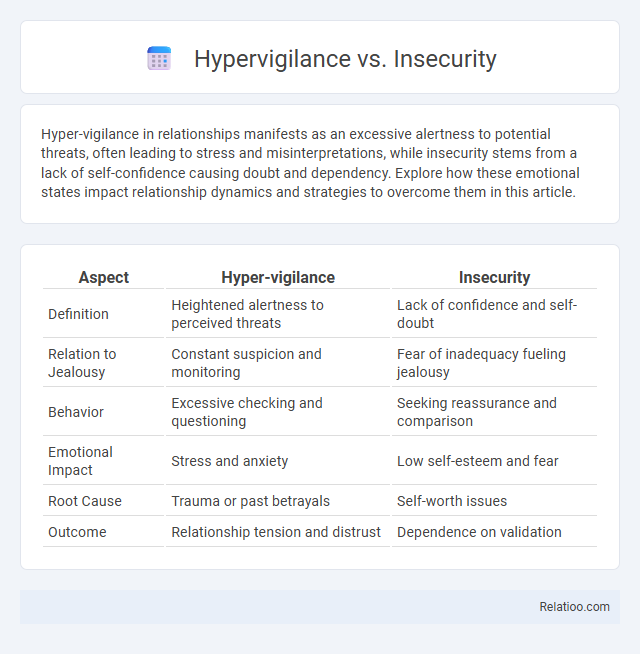Hyper-vigilance in relationships manifests as an excessive alertness to potential threats, often leading to stress and misinterpretations, while insecurity stems from a lack of self-confidence causing doubt and dependency. Explore how these emotional states impact relationship dynamics and strategies to overcome them in this article.
Table of Comparison
| Aspect | Hyper-vigilance | Insecurity |
|---|---|---|
| Definition | Heightened alertness to perceived threats | Lack of confidence and self-doubt |
| Relation to Jealousy | Constant suspicion and monitoring | Fear of inadequacy fueling jealousy |
| Behavior | Excessive checking and questioning | Seeking reassurance and comparison |
| Emotional Impact | Stress and anxiety | Low self-esteem and fear |
| Root Cause | Trauma or past betrayals | Self-worth issues |
| Outcome | Relationship tension and distrust | Dependence on validation |
Understanding Hyper-vigilance and Insecurity
Hyper-vigilance involves an intense, constant state of alertness to potential threats, often linked to anxiety disorders or trauma, whereas insecurity stems from a lack of confidence and self-esteem, influencing emotional stability and social interactions. Understanding hyper-vigilance requires recognizing its physiological and psychological impact, such as heightened sensitivity to stimuli and persistent fear responses, while insecurity primarily affects your self-perception and interpersonal relationships. Differentiating these conditions helps tailor coping strategies and therapeutic interventions for improved mental health outcomes.
Key Differences Between Hyper-vigilance and Insecurity
Hyper-vigilance involves an acute, persistent state of heightened alertness often linked to trauma responses, whereas insecurity primarily reflects self-doubt and fear of judgment. You can differentiate hyper-vigilance by its focus on external threats and constant scanning for danger, contrasting insecurity's internal struggles with self-worth and acceptance. Understanding these distinctions helps tailor effective coping strategies for emotional well-being.
Psychological Roots of Hyper-vigilance
Hyper-vigilance arises from psychological roots such as trauma, chronic stress, and anxiety disorders, where the brain's threat detection system becomes overactive to anticipate danger. Insecurity, contrastingly, stems from low self-esteem and uncertainty in personal abilities or relationships, often leading to increased sensitivity but not the constant alertness seen in hyper-vigilance. Understanding these differences aids in targeted mental health interventions for trauma-related hyper-vigilance versus insecurity-driven behaviors.
Common Causes of Insecurity
Common causes of insecurity include childhood experiences such as neglect or criticism, social comparison leading to feelings of inadequacy, and traumatic events that disrupt self-confidence. These factors often result in persistent self-doubt and fear of judgment, differentiating insecurity from hyper-vigilance, which is characterized by an intense focus on potential threats and heightened sensory awareness. Understanding these causes is essential for developing targeted interventions to address underlying issues contributing to insecurity.
Behavioral Signs of Hyper-vigilance
Behavioral signs of hyper-vigilance include constant scanning of the environment for potential threats, exaggerated startle responses, and difficulty concentrating due to heightened alertness. Unlike insecurity, which is characterized by self-doubt and fear of judgment, hyper-vigilance manifests as an intense state of sensory sensitivity and an inability to relax. Understanding these distinct signs helps you identify when hyper-vigilance impacts your daily functioning and stress levels.
How Insecurity Manifests in Daily Life
Insecurity often manifests in daily life through constant self-doubt, fear of judgment, and heightened sensitivity to criticism, which can lead to avoidance of social interactions and missed opportunities. Unlike hyper-vigilance, characterized by excessive alertness to potential threats due to anxiety or trauma, insecurity centers on internalized feelings of inadequacy and low self-worth. Recognizing these distinctions aids in targeted mental health approaches, improving emotional resilience and interpersonal relationships.
Impact on Relationships: Hyper-vigilance vs Insecurity
Hyper-vigilance often leads to heightened alertness and mistrust in relationships, causing partners to feel overwhelmed or constantly scrutinized, which can erode emotional intimacy. Insecurity typically manifests as self-doubt and fear of abandonment, resulting in clinginess or neediness that strains communication and mutual trust. Both conditions disrupt relationship stability, but hyper-vigilance drives defensive behaviors while insecurity fosters dependency and emotional vulnerability.
Coping Strategies for Hyper-vigilance
Coping strategies for hyper-vigilance prioritize grounding techniques such as deep breathing, mindfulness, and sensory engagement to reduce overactive alertness. Cognitive-behavioral therapy (CBT) helps reframe intrusive thoughts and build emotional resilience, while establishing a consistent routine can create a sense of safety and predictability. Support from mental health professionals and peer groups further aids in managing hyper-vigilance by addressing underlying trauma and promoting self-regulation skills.
Managing and Overcoming Insecurity
Managing and overcoming insecurity involves building self-awareness and developing coping strategies tailored to individual triggers. Cognitive-behavioral techniques, such as challenging negative thoughts and practicing self-compassion, are effective in reducing feelings of inadequacy and fostering resilience. Establishing strong social support networks and engaging in mindfulness practices can mitigate insecurity's impact and promote emotional stability.
Seeking Professional Help: When Symptoms Persist
Persistent hyper-vigilance, insecurity, and anxiety symptoms often indicate underlying mental health conditions that require evaluation by a qualified therapist or psychiatrist. Professional help includes cognitive-behavioral therapy (CBT), trauma-focused therapy, and, in some cases, medication management to address chronic stress responses and emotional dysregulation. Early intervention with mental health specialists improves outcomes by targeting maladaptive thought patterns and enhancing emotional resilience.

Infographic: Hyper-vigilance vs Insecurity
 relatioo.com
relatioo.com